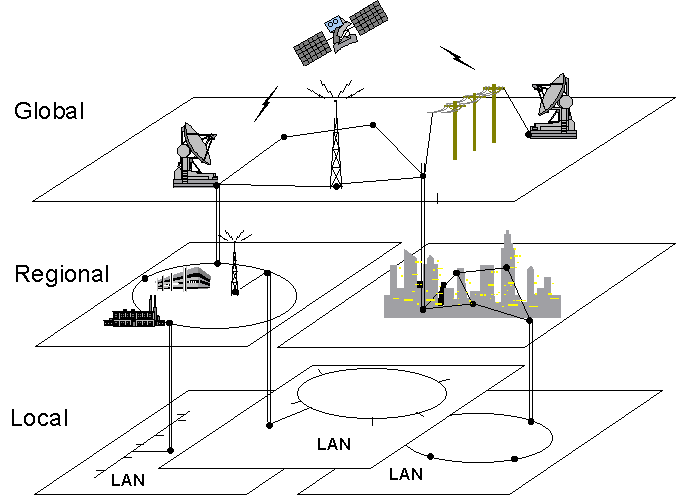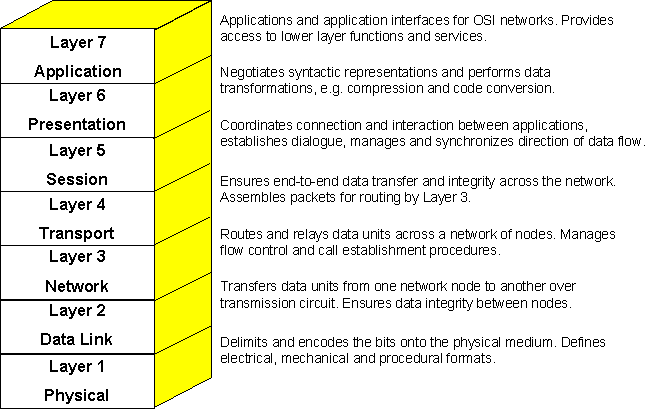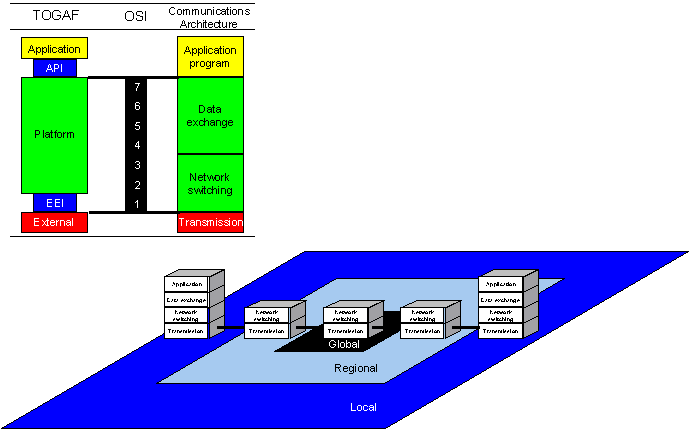
Stakeholder and Concerns Modeling the View Key Issues Infrastructure Models
This view should be developed for the communications engineering personnel of the system, and should focus on how the system is implemented from the perspective of the communications engineer.
Communications engineers are typically concerned with location, modifiability, reusability and availability of communications and networking services. Major concerns for this view are understanding the network and communications requirements. In general these stakeholders are concerned with assuring that the appropriate communications and networking services are developed and deployed within the system in an optimal manner.
Developing this view assists in the selection of the best model of communications for the system.
The general architecture of a "communications system" can be modeled with ADML (components, ports, connectors, and roles).
Communications networks are constructed of end devices (e.g., printers), processing nodes, communication nodes (switching elements), and the linking media that connect them. The communications network provides the means by which information is exchanged. Forms of information include data, imagery, voice, and video. Because automated information systems accept and process information using digital data formats rather than analogue formats, the TOGAF communications concepts and guidance will focus on digital networks and digital services. Integrated multimedia services are included.
The communications engineering view describes the communications architecture with respect to geography, discusses the Open Systems Interconnection (OSI) reference model, and describes a general framework intended to permit effective system analysis and planning.
The communications infrastructure may contain up to three levels of transport - local, regional/metropolitan, and global, as shown in Figure 1. The names of the transport components are based on their respective geographic extent, but there is also a hierarchical relationship among them. The transport components correspond to a network management structure in which management and control of network resources are distributed across the different levels.
The local components relate to assets that are located relatively close together geographically. This component contains fixed communications equipment and small units of mobile communications equipment. Local area networks (LANs), to which the majority of end devices will be connected, are included in this component. Standard interfaces will facilitate portability, flexibility, and interoperability of LANs and end devices.
Regional and metropolitan area networks (MANs) are geographically dispersed over a large area. A regional or metropolitan network could connect local components at several fixed bases or connect separate remote outposts. In most cases, regional and metropolitan networks are used to connect local networks. However, shared databases, regional processing platforms, and network management centers may connect directly or through a LAN. Standard interfaces will be provided to connect local networks and end devices.
Global or wide area networks (WANs) are located throughout the world, providing connectivity for regional and metropolitan networks in the fixed and deployed environment. In addition, mobile units, shared databases, and central processing centers can connect directly to the global network as required. Standard interfaces will be provided to connect regional and metropolitan networks and end devices.

Figure 1: Communications Infrastructure
The geographically divided infrastructure described above forms the foundation for an overall communications framework. These geographic divisions permit the separate application of different management responsibilities, planning efforts, operational functions, and enabling technologies to be applied within each area. Hardware and software components and services fitted to the framework form the complete model.
The following sections describe the OSI reference model and a grouping of the OSI layers that facilitates discussion of interoperability issues.
The Open Systems Interconnection (OSI) reference model, portrayed in Figure 2, is the model used for data communications in TOGAF. Each of the seven layers in the model represents one or more services or protocols (a set of rules governing communications between systems), which define the functional operation of the communications between user and network elements. Each layer (with the exception of the top layer) provides services for the layer above it. This model aims at establishing open systems operation and implies standards-based implementation. It strives to permit different systems to accomplish complete interoperability and quality of operation throughout the network.
The seven layers of the OSI model are structured to facilitate independent development within each layer and to provide for changes independent of other layers. Stable international standard protocols in conformance with the OSI reference model layer definitions have been published by various standards organizations. This is not to say that the only protocols which fit into TOGAF are OSI protocols. Other protocol standards such as SNA or TCP/IP can be described using the OSI seven layer model as a reference.
Support and business-area applications, as defined in TOGAF, are above the OSI Reference Model protocol stack and use its services via the applications layer.
Communications Framework
A communications system based on the OSI reference model includes services in all the relevant layers, the support and business-area application software which sits above the Application layer of the OSI model, and the physical equipment carrying the data. These elements may be grouped into architectural levels that represent major functional capabilities, such as switching and routing, data transfer, and the performance of applications.

Figure 2: Open Systems Interconnection Model
These architectural levels are:
The communications framework is defined to consist of the three geographical components of the communications infrastructure (local, regional, and global) and the four architectural levels (transmission, network switching, data exchange, and application program), and is depicted in Figure 3. Communications services are performed at one or more of these architectural levels within the geographical components. Figure 3 shows computing elements (operating at the applications program level) with supporting data exchange elements, linked with each other through various switching elements (operating at the network switching level), each located within its respective geographical component. Figure 3 also identifies the relationship of The Open Group Architectural Framework to the communication architecture.

Figure 3: Communications Framework
The communications infrastructure consists of the local, regional, and global transport components. The services allocated to these components are identical to the services of the application program, data exchange, network switching, or transmission architectural levels that apply to a component. Data exchange and network switching level services are identical to the services of the corresponding OSI reference model layers. Typically, only network switching and transmission services are allocated to the regional and global components, which consist of communications nodes and transmission media. All services may be performed in the local component, which includes end devices, processing nodes, communications nodes, and linking media. Transmission, switching, transport, and applications are all performed in this component.
Copyright © The Open Group, 1998, 2000